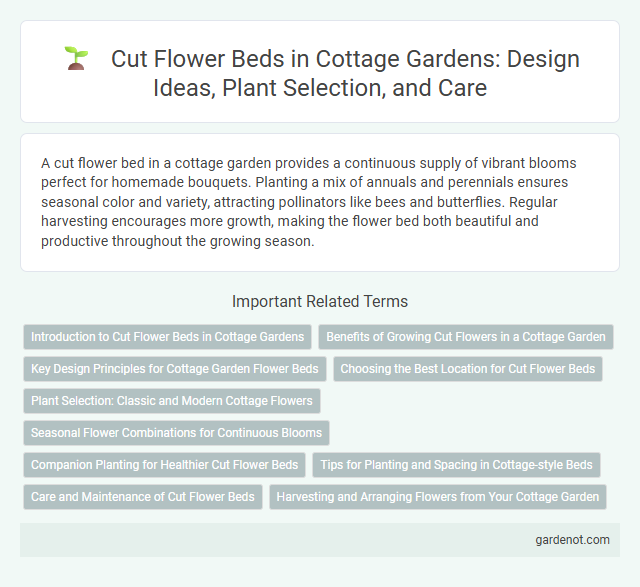A cut flower bed in a cottage garden provides a continuous supply of vibrant blooms perfect for homemade bouquets. Planting a mix of annuals and perennials ensures seasonal color and variety, attracting pollinators like bees and butterflies. Regular harvesting encourages more growth, making the flower bed both beautiful and productive throughout the growing season.
Introduction to Cut Flower Beds in Cottage Gardens
Cut flower beds in cottage gardens serve as vibrant, fragrant focal points, blending ornamental blooms with practical harvesting. These beds typically feature a diverse mix of annuals, perennials, and herbs optimized for continuous cut flower supply throughout the growing season. Incorporating varieties such as dahlias, cosmos, and sweet peas enhances the visual appeal and supports sustainable bouquet making.
Benefits of Growing Cut Flowers in a Cottage Garden
Growing cut flowers in a cottage garden enhances its aesthetic appeal by adding vibrant colors and natural textures that attract pollinators like bees and butterflies. This practice promotes sustainable gardening by providing a continuous supply of fresh blooms for indoor arrangements, reducing the need for commercially grown flowers. Cultivating cut flowers also supports biodiversity and helps maintain a healthy ecosystem within the garden.
Key Design Principles for Cottage Garden Flower Beds
Cut flower beds in cottage gardens prioritize a mix of vibrant, fragrant blooms arranged with an informal, layered planting style to maximize visual interest and seasonal color. Emphasis on plant diversity and staggered bloom times ensures continuous harvest for bouquets, combining perennials like foxgloves and hollyhocks with annuals such as sweet peas and cosmos. Incorporating soft edges and naturalistic groupings reflects the quintessential cottage garden aesthetic while promoting easy access for cutting flowers.
Choosing the Best Location for Cut Flower Beds
Selecting the best location for cut flower beds involves prioritizing areas with at least six hours of direct sunlight daily to support vibrant blooms. Soil should be well-drained and rich in organic matter to ensure healthy root development and prolonged flower production. Positioning the bed near pathways or patios enhances accessibility for regular cutting and enjoyment of fresh flowers indoors.
Plant Selection: Classic and Modern Cottage Flowers
Select a variety of classic cottage garden flowers such as foxgloves, hollyhocks, and sweet peas to create a traditional cut flower bed rich in texture and color. Incorporate modern varieties like dahlias, zinnias, and cosmos to add vibrant hues and prolonged blooming seasons. Prioritize plants with sturdy stems and repeated flowering traits to ensure a continuous supply of fresh cut flowers for indoor arrangements.
Seasonal Flower Combinations for Continuous Blooms
Planting a cut flower bed in a cottage garden with seasonal flower combinations ensures a vibrant display of continuous blooms from spring through fall. Incorporate early bloomers like tulips and daffodils with mid-season staples such as dahlias and phlox, followed by late bloomers including asters and chrysanthemums. This strategic layering maximizes flower availability for cutting, providing fresh arrangements throughout the growing season.
Companion Planting for Healthier Cut Flower Beds
Companion planting in cut flower beds enhances plant health by naturally deterring pests and improving soil nutrients, promoting vibrant blooms. Combining marigolds with roses or lavender with daisies creates synergies that reduce disease and attract beneficial pollinators. This strategic planting method supports sustainable growth and yields abundant, long-lasting cut flowers for cottage garden arrangements.
Tips for Planting and Spacing in Cottage-style Beds
Plant hardy perennials and annuals such as foxgloves, hollyhocks, and daisies in the cut flower bed for a lush, seasonal bounty. Space plants according to their mature width, generally keeping 12 to 18 inches apart, to ensure good air circulation and reduce fungal diseases. Incorporate layered heights by placing taller blooms like delphiniums in the back and shorter flowers like cosmos in the front to maximize visual appeal and ease of harvesting.
Care and Maintenance of Cut Flower Beds
Regular watering and soil enrichment with organic compost enhance the vitality of cut flower beds in cottage gardens. Pruning spent blooms encourages continuous flowering and prevents disease by improving air circulation. Mulching with natural materials like straw or bark preserves moisture and suppresses weeds, ensuring a lush, vibrant display throughout the growing season.
Harvesting and Arranging Flowers from Your Cottage Garden
Harvest flowers from your cottage garden in the early morning when blooms are fresh and hydrated to extend vase life. Use sharp garden scissors or pruners to make clean cuts just above a leaf node or side shoot, encouraging continued growth. Arrange flowers in water immediately, mixing varied textures and colors like fragrant roses, daisies, and lavender for a vibrant, natural bouquet.
Cut flower bed Infographic

 gardenot.com
gardenot.com